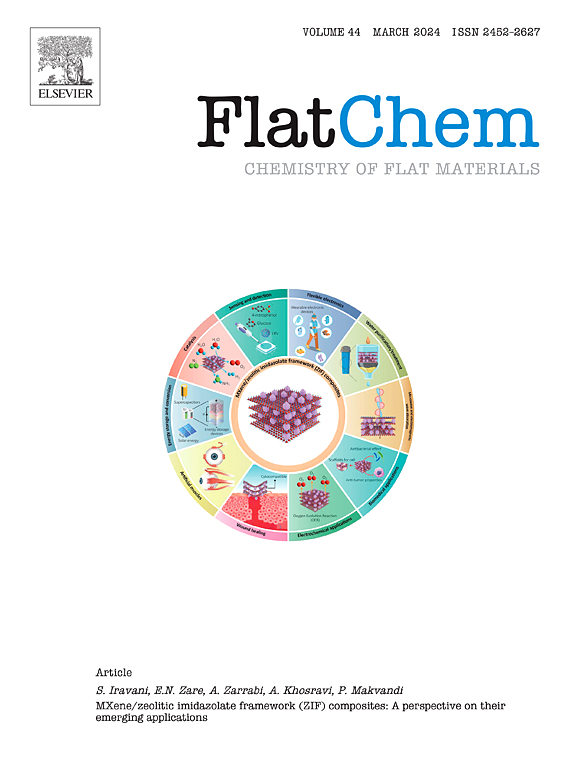Unravelling the role of heteroatom modifications in Bismuthene towards OER performance
IF 6.2
3区 材料科学
Q2 CHEMISTRY, PHYSICAL
引用次数: 0
Abstract
Bismuthene, an emergent two-dimensional material, exhibits potential for energy applications but requires enhancement in electrocatalytic efficiency. This study investigates the impact of individual heteroatom doping- boron (B), nitrogen (N), oxygen (O), and sulfur (S)-on bismuthene to optimize its catalytic performance. Structural and compositional modifications were analyzed using X-ray diffraction (XRD), X-ray photoelectron spectroscopy (XPS), Raman spectroscopy, scanning electron microscopy (SEM), and transmission electron microscopy (TEM). Electrochemical studies, including cyclic voltammetry (CV), linear sweep voltammetry (LSV), and electrochemical impedance spectroscopy (EIS), reveal that nitrogen-doped bismuthene (Biene-N) demonstrates the lowest overpotential of 350 mV at 50 mA cm−2 with a Tafel slope of 78 mV dec−1 for the oxygen evolution reaction (OER). Stability tests confirm 24-h durability with the decrement of overpotential of 30 mV, attributed to self-reconstruction. The findings highlight the role of heteroatom doping in modulating electronic structure and surface activity, providing a new pathway for efficient, cost-effective metallenes-based electrocatalysts in sustainable energy technologies. This study provides insights into the role of targeted heteroatom doping in optimizing bismuthene for sustainable energy technologies, offering a pathway for developing efficient and cost-effective energy solutions.

揭示铋中杂原子修饰对OER性能的作用
铋是一种新兴的二维材料,具有能源应用的潜力,但需要提高电催化效率。本研究考察了硼(B)、氮(N)、氧(O)和硫(S)等杂原子掺杂对铋烯催化性能的影响,以优化其催化性能。采用x射线衍射(XRD)、x射线光电子能谱(XPS)、拉曼光谱(Raman spectroscopy)、扫描电镜(SEM)和透射电镜(TEM)分析了结构和成分的变化。包括循环伏安法(CV)、线性扫描伏安法(LSV)和电化学阻抗谱(EIS)在内的电化学研究表明,氮掺杂铋(Biene-N)在50 mA cm−2下的过电位最低为350 mV, Tafel斜率为78 mV dec−1,用于析氧反应(OER)。稳定性测试证实了24小时的耐久性,由于自重构,过电位降低了30 mV。这些发现突出了杂原子掺杂在调制电子结构和表面活性方面的作用,为可持续能源技术中高效、经济的金属基电催化剂提供了新的途径。该研究揭示了靶向杂原子掺杂在优化铋可持续能源技术中的作用,为开发高效、经济的能源解决方案提供了途径。
本文章由计算机程序翻译,如有差异,请以英文原文为准。
求助全文
约1分钟内获得全文
求助全文
来源期刊

FlatChem
Multiple-
CiteScore
8.40
自引率
6.50%
发文量
104
审稿时长
26 days
期刊介绍:
FlatChem - Chemistry of Flat Materials, a new voice in the community, publishes original and significant, cutting-edge research related to the chemistry of graphene and related 2D & layered materials. The overall aim of the journal is to combine the chemistry and applications of these materials, where the submission of communications, full papers, and concepts should contain chemistry in a materials context, which can be both experimental and/or theoretical. In addition to original research articles, FlatChem also offers reviews, minireviews, highlights and perspectives on the future of this research area with the scientific leaders in fields related to Flat Materials. Topics of interest include, but are not limited to, the following: -Design, synthesis, applications and investigation of graphene, graphene related materials and other 2D & layered materials (for example Silicene, Germanene, Phosphorene, MXenes, Boron nitride, Transition metal dichalcogenides) -Characterization of these materials using all forms of spectroscopy and microscopy techniques -Chemical modification or functionalization and dispersion of these materials, as well as interactions with other materials -Exploring the surface chemistry of these materials for applications in: Sensors or detectors in electrochemical/Lab on a Chip devices, Composite materials, Membranes, Environment technology, Catalysis for energy storage and conversion (for example fuel cells, supercapacitors, batteries, hydrogen storage), Biomedical technology (drug delivery, biosensing, bioimaging)
 求助内容:
求助内容: 应助结果提醒方式:
应助结果提醒方式:


